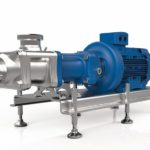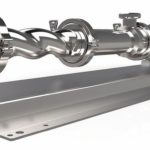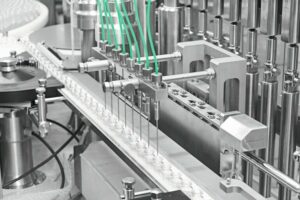Mr. Renzelmann, how badly did the coronavirus crisis hit
Pumpenfabrik Wangen?
Klaus Renzelmann: Actually, we did really well throughout the first half of the year. March, April and May were real record months for us. We do not know how the situation will continue as the coronavirus will tend to have more and more of an impact on new projects.
Let us now talk about the Twin range of twin screw pumps. Since when have the pumps been part of your company’s product range?
Renzelmann: We initially launched the Twin pumps at Anuga Foodtec 2012, but only sizes 104 and 130 back then. Since then, the pumps have been used in a wide variety of different sectors. Our engineers continued to gradually develop the pumps based on the experience we gained there. The Twin NG series of twin screw pumps is the result of this continuous development work, and this year we will replace its predecessor, the Twin range.
How do Twin NG pumps differ from the previous models?
Renzelmann: Through their significantly improved ease of service. This starts with the handles on the pumps, which make the removal of the pump housing more convenient. Then the seals now have a cartridge design, which makes it considerably easier to replace the seal. A self-centering flange housing also ensures alignment of the coupling after service work. And, last but not least, the Twin NG pumps are equipped with Fast-X-Change technology.
What is behind this technology?
Renzelmann: It is a process for automatic synchronisation of the spindles. During installation or maintenance of the pump, the screw spindles simply need to be attached without the need for re-synchronisation. Fast-X-Change makes changing the spindle unbelievably easy, saves valuable time, avoids sources of error, and ultimately simplifies the adjustment of the pump to the media to be pumped. An important point to stress at this point: we have significantly increased the variety of different spindles with the Twin NG pumps.
Does the operator need to remove the pump when changing the spindle?
Renzelmann: No. The pump housing, complete with all its connections, can remain in the system. The pump simply needs to be opened and the old spindles replaced by new ones.
What about the robustness of the pumps?
Renzelmann: Once again here, the Twin NG pumps have much to offer. For instance, particularly under harsh operating conditions, shaft protection sleeves ensure that the shafts do not run into the radial shaft seals as easily, and hence also prevent oil losses. Moreover, the couplings have a ledge, which prevents them from hitting the housing should they become loose.
What sizes of pump are available?
Renzelmann: They are available in sizes 70, 104, 130 and 180. The smallest pump, the Twin NG 70, has a pump capacity of 25 m3/h. This figure rises to 200 m3/h with the largest pump, the Twin NG 180. The pump capacities are based on media with a viscosity of 1 mPas. The pumps can be used for media with a viscosity of up to 1,000,000 mPas.
Please give us a few examples of products that can be used with the pump.
Renzelmann: The products range from low-viscosity products, such as alcohol, juices, cleaning agents and water, to liquid sugar, soups, mayonnaise and fruit preparations, and even high-viscosity pulps, tomato purée, dough or sausage meat. It is important that the same pump can be used to pump low- and high-viscosity products. This means that Twin NG pumps can be used as product pumps and also as CIP pumps. Customers save the cost of a separate centrifugal pump, bypass lines, valves and measuring technology etc.
In which materials are Twin NG pumps available?
Renzelmann: Wetted components are generally made of higher-quality stainless steel. However, we can also supply a galvanised or coated grey cast iron bearing housing, with all wetted components continuing to be made of stainless steel.
What qualities of stainless steel are used?
Renzelmann: We manufacture, as standard, in stainless steel 4404 or 4408. Special materials, such as Duplex or Hastelloy, are available on request.
What hygienic standards or guidelines do the pumps meet?
Renzelmann: We are permitted to use the 3-A label and EHEDG for the Twin NG 70, Twin NG104 and Twin NG 130 pumps. All four sizes also achieve excellent values with CIP and SIP cleaning. Thanks to their ease of disassembly the pumps can also be manually cleaned very easily – a factor that becomes increasingly important if the pumps cannot be process-reliably cleaned by CIP.
In what sectors are the pumps used?
Renzelmann: The food industry is the major customer. The pumps are also used in the chemical industry, especially in areas where large volumes of product need to be pumped and where the ability to clean the pump is crucial. I am thinking here about the production of paints and coatings.
And what about the pharmaceutical industry?
Renzelmann: These pumps are rarely used in that sector. However, this industry is one of the main customers of our MX range of progressing cavity pumps.
That was a very elegant link to the second part of our interview in which I would like to talk to you about MX progressing cavity pumps. How do these pumps differ from your company’s other progressing cavity pumps?
Renzelmann: We took over these pumps from Knoll. They ideally complete the top of our range of hygienic progressing cavity pumps – they are essentially the icing on the cake. These totally hygienic pumps are designed for applications in which very high pressures need to be generated in a few steps and where pumping precision is crucial.
Does that mean that Wangen’s other progressing cavity pumps are not as hygienic and precise in terms of metering?
Renzelmann: No, they are not. But they have other strengths, such as their excellent robustness to foreign matter.
The MX range includes the four pump designs MX-R, MX-S, MX-T and MX-F. How do these pumps differ from each other?
Renzelmann: The MX-R is a hopper feed pump, which is suitable for use with high-viscosity products that are no longer free-flowing. The MX-S is a suction design of progressing cavity pump. The MX-T and MX-F designs are designed for vertical operation and so are perfect for various metering and transfer tasks, with the MX-F also featuring a follower plate. All the above pump designs share a common feature: all their stators have an EvenWall design.
Please explain this technology to us.
Renzelmann: With EvenWall technology, the stator casing is adapted to the inner contour of the stator and has a uniformly thick 4 to 12 mm thick elastomer layer. This results in attractive benefits to users compared to conventional progressing cavity pumps with a cylindrical outer stator casing geometry and correspondingly different elastomer wall thicknesses: MX pumps achieve considerably higher pressure stability, there is less backflow, fewer downtimes and their efficiency is extended. Other benefits include less shearing of the products being pumped and improved suction behaviour. Moreover, thanks to EvenWall technology, the pumps generate 10 bar per pressure stage. This value is between 4 and 6 bar with conventional progressing cavity pumps. As the MX pumps can be designed as multi-stage pumps, this enables them to achieve pressures of up to 80 bar – coupled with their extremely compact design.
Are there other benefits apart from the special design of the stator?
Renzelmann: Definitely. The pumps have a modular design so that they can be easily adapted to the most diverse applications. Their sealing chamber is generously sized providing space for all possible sealing arrangements.
Are the pumps CIP- and SIP-capable?
Renzelmann: But of course. They are also designed to be easy-to-clean with no dead spaces. EHEDG and 3-A Sanitary Standard certification approval will come in the next weeks.
Let us now talk about the materials used.
Renzelmann: We use stainless steels 1.4571, 1.4404 and 1.4301 for the wetted metal components. The elastomer components are made of different materials, which are all FDA-compliant and approved according to EU 1935/2004. They include EPDM, NBR and fluoroelastomers.
What capacities do the MX progressing cavity pumps provide?
Renzelmann: We supply four designs of pumps, with each one being available in several sizes. Apart from the viscosity of the product being pumped, the capacity, of course, also depends on the pump being used. The capacity range extends from 1 to 100,000 l/h.
What about the viscosity of the products being pumped?
Renzelmann: MX pumps are able to pump both low and high viscosity media. They work very well with low-viscosity products at low capacity. This is because MX pumps do not experience the slippage that frequently occurs with twin screw pumps.
Where are the pumps used in the chemical industry?
Renzelmann: Yes. For instance, a paint and coatings manufacturer has 60 of these pumps in its company. In the pharmaceutical industry, they are used, among other things, for the metering of ointments.
Online search: Pumpenfabrik Wangen
Pumpenfabrik Wangen: Facts & Figures
Dr. Herbert Wallbrecher founded Pumpenfabrik Wangen in 1969. Over the past 50 years, his small craft business with a handful of employees has grown into a globally operating plant manufacturer. The displacement pump specialist today employs around 250 people. The company’s product range includes progressing cavity pumps and twin screw pumps for the food and beverage industry as well as for the pharmaceutical, cosmetics and chemical industries. The pumps are developed and produced at the company’s headquarters in Wangen. The medium-sized company also has a branch in Schwerin and a subsidiary in the USA. The international sales of pumps rely on a global network of sales and distribution partners. The international sales and distribution network is currently being expanded to include partners in Great Britain, Ireland, Northern Ireland, Australia and New Zealand.
Pumpenfabrik Wangen recorded a turnover of around 46 million euros in 2019.
The interview was conducted by:Lukas Lehmann
Assistant Editor-in-Chief
„The MX pumps are the icing on the cake. They round off the top of our range of progressing cavity pumps in terms of hygiene and pumping precision.“









